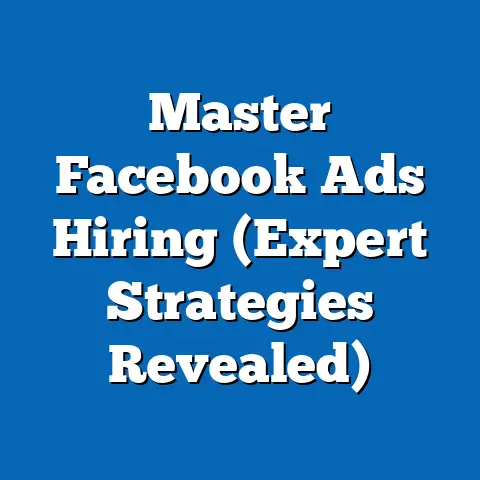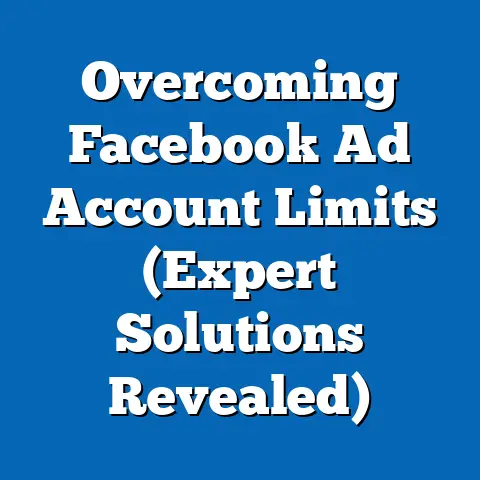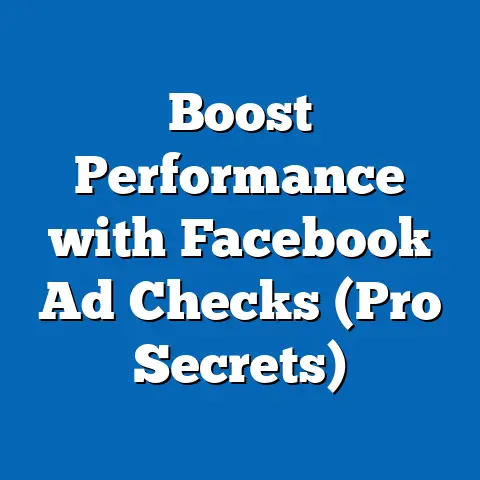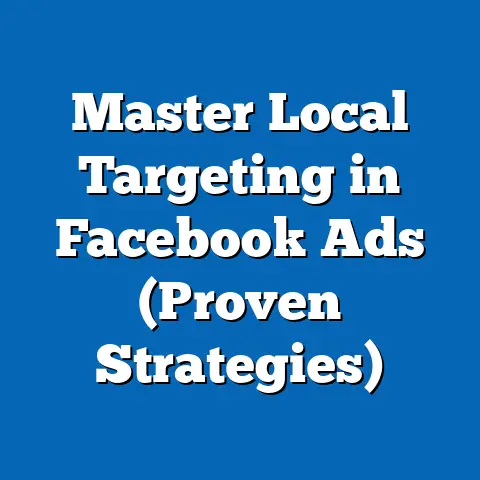Boost Facebook Ads with Stunning Images (Pro Tips)
In today’s digital landscape, visual content reigns supreme. On platforms like Facebook, where users are bombarded with information, a compelling image can be the difference between a scroll-past and a click-through. I’ve seen it firsthand – the right image can breathe life into an otherwise stagnant campaign, transforming it from a cost center into a lead-generating machine.
We’re not just talking about any image, though. We’re talking about stunning images. Images that stop thumbs, evoke emotion, and ultimately drive action. What’s even better is that you don’t need to be a professional designer to create these images. Low-maintenance options like stock photos, customizable templates, and simple graphics can be just as effective, especially when used strategically.
In this guide, I’ll share pro tips for selecting and using stunning images to significantly enhance your Facebook ad campaigns. We’ll dive into the psychology of visuals, explore different image types, and uncover tools that make image creation accessible to everyone. Get ready to transform your Facebook ads from bland to brilliant!
Understanding the Role of Images in Facebook Ads
The human brain processes visual information a staggering 60,000 times faster than text. Think about that for a second. In the blink of an eye, an image can convey a message, evoke an emotion, and capture attention far more effectively than a wall of text ever could. This is why images are absolutely crucial in the fast-paced world of Facebook advertising.
I remember one campaign I ran for a local bakery. We initially used text-based ads highlighting their daily specials. The results were… underwhelming. Then, we switched to mouthwatering images of freshly baked pastries. The difference was night and day. Click-through rates skyrocketed, and the bakery saw a significant increase in foot traffic.
Statistics consistently back this up. Ads with high-quality, relevant images see significantly higher engagement rates. In fact, studies have shown that Facebook ads with images receive up to 2.3 times more engagement than those without. This translates to increased click-through rates (CTR), lower cost per click (CPC), and ultimately, a better return on investment (ROI).
Why is this? Because stunning images tap into our emotions and desires. They tell a story, create a connection, and make us want to learn more. They break through the noise and grab our attention in a way that text simply can’t.
Takeaway: Images are not just decorative elements in your Facebook ads; they are the foundation of a successful campaign. They are the hook that grabs attention, the storyteller that conveys your message, and the catalyst that drives action.
Choosing the Right Type of Image
Not all images are created equal. The type of image you choose for your Facebook ad can have a significant impact on its performance. Let’s explore some different types of images that work well:
- Product Photos: These are ideal for showcasing your products in their best light. Use high-quality images that highlight the features and benefits of your product. Consider different angles, close-ups, and lifestyle shots that show the product in use.
- Lifestyle Images: These images focus on showcasing the experience or lifestyle associated with your product or service. They help your audience envision themselves using your product and enjoying the benefits it offers.
- Infographics: These are great for conveying complex information in a visually appealing and easy-to-understand format. Use infographics to highlight key statistics, data points, or processes related to your product or service.
- User-Generated Content (UGC): Featuring real customers using your product can build trust and credibility. UGC adds authenticity to your ads and shows potential customers that others are enjoying your product.
The key is to align your image choice with your brand identity and target audience preferences. What resonates with one audience may not resonate with another. Consider your brand’s personality, values, and target audience demographics when selecting images.
For example, a luxury brand might use elegant, high-fashion lifestyle images to appeal to their affluent target audience. A fitness brand, on the other hand, might use action-packed images of people working out to motivate their health-conscious audience.
I once worked with a travel agency that was struggling to attract bookings to their adventure tours. We initially used generic stock photos of landscapes. Then, we switched to UGC featuring real customers enjoying the tours. The response was incredible. People connected with the authenticity of the images, and bookings soared.
Takeaway: Choosing the right type of image is crucial for capturing attention and resonating with your target audience. Consider your brand identity, target audience preferences, and the message you want to convey when selecting images for your Facebook ads.
Key Elements of Stunning Images
So, what makes an image truly “stunning”? It’s more than just a pretty picture. Several key elements contribute to an image’s effectiveness in capturing attention and driving action:
- Clarity: The image should be sharp, clear, and easy to understand. Avoid blurry or pixelated images.
- Composition: The arrangement of elements within the image should be visually appealing and balanced. Use techniques like the rule of thirds to create a more dynamic and engaging composition.
- Color: Color plays a powerful role in evoking emotions and capturing attention. Use colors that are consistent with your brand identity and that resonate with your target audience.
- Relevance: The image should be directly relevant to your product, service, or offer. It should clearly communicate the value proposition and entice viewers to learn more.
High resolution and professional quality are also essential. A pixelated or poorly lit image can reflect negatively on your brand’s credibility. Invest in high-quality photography or use stock photos from reputable sources.
I’ve often found that simple tweaks can make a big difference. For instance, adjusting the brightness and contrast, cropping the image to focus on the key subject, or adding a subtle filter can enhance its visual appeal.
Remember that bakery campaign I mentioned earlier? We initially used images taken with a smartphone. While they were decent, they lacked the professional polish that would truly make the pastries shine. We hired a professional photographer for a few hours, and the results were transformative. The images were crisp, well-lit, and showcased the pastries in all their glory.
Takeaway: Stunning images are not just about aesthetics; they are about clarity, composition, color, and relevance. Invest in high-quality photography and pay attention to the details that make an image visually appealing and engaging.
Tools and Resources for Creating Images
You don’t need to be a graphic design guru to create stunning images for your Facebook ads. Thanks to a plethora of user-friendly tools and resources, anyone can create visually appealing content without extensive design skills.
- Canva: This is my go-to tool for creating social media graphics. It offers a wide range of templates, design elements, and fonts that you can customize to create professional-looking images in minutes. Canva’s drag-and-drop interface is incredibly intuitive, making it easy for beginners to get started.
- Adobe Spark: Another excellent option for creating social media graphics, Adobe Spark offers a similar range of templates and design tools as Canva. It also integrates seamlessly with other Adobe Creative Cloud apps, making it a great choice for designers who are already familiar with the Adobe ecosystem.
- Mobile Apps: Don’t underestimate the power of mobile apps for creating on-the-go graphics. Apps like Over, PicsArt, and Snapseed offer a variety of editing tools, filters, and design elements that you can use to create stunning images right from your smartphone.
- Stock Photo Websites: For sourcing high-quality images, stock photo websites like Unsplash, Pexels, and Shutterstock are invaluable resources. These websites offer a vast library of royalty-free images that you can use in your Facebook ads without worrying about copyright issues.
The key is to find a tool that fits your skill level and budget. Experiment with different platforms and find one that you feel comfortable using.
I often use Canva to create variations of ad images quickly for A/B testing. It’s so easy to duplicate a design and change a few elements, like the headline or the background color, to see what resonates best with my audience.
Takeaway: You don’t need to be a professional designer to create stunning images for your Facebook ads. A variety of user-friendly tools and resources are available to help you create visually appealing content without extensive design skills.
Testing and Analyzing Image Performance
Creating stunning images is only half the battle. The real magic happens when you start testing and analyzing their performance to see what resonates best with your audience.
A/B testing is your best friend here. Create multiple versions of your ad with different images and run them simultaneously to see which one performs best. Test different image types, compositions, colors, and headlines to identify the winning combination.
Key metrics to track when analyzing image performance include:
- Engagement Rate: This measures how much your audience is interacting with your ad (likes, comments, shares).
- Click-Through Rate (CTR): This measures the percentage of people who see your ad and click on it.
- Conversion Rate: This measures the percentage of people who take a desired action after clicking on your ad (e.g., making a purchase, filling out a form).
By tracking these metrics, you can gain valuable insights into what types of images are most effective at capturing attention and driving conversions.
I remember working with an e-commerce client who was struggling to generate sales with their Facebook ads. We initially used product photos with a white background. They were clean and professional, but they weren’t generating much excitement. We then tested lifestyle images of people using the products in different settings. The results were remarkable. The lifestyle images generated significantly higher engagement rates and conversion rates.
Based on this data, we shifted our focus to lifestyle images and saw a dramatic increase in sales.
Takeaway: Testing and analyzing image performance is crucial for optimizing your Facebook ad campaigns. Use A/B testing to experiment with different images and track key metrics like engagement rate, CTR, and conversion rate to identify the winning combinations.
Staying Updated with Trends in Visual Content
The world of visual content is constantly evolving. What works today may not work tomorrow. That’s why it’s essential to stay updated with the latest trends and adapt your image strategies accordingly.
Some current trends in visual content that are gaining traction on social media include:
- Video Ads: Video continues to be a powerful medium for capturing attention and telling stories.
- AR Filters: Augmented reality filters offer a fun and interactive way to engage with your audience.
- Interactive Content: Quizzes, polls, and other interactive content formats can boost engagement and generate leads.
Keeping up with design trends is also crucial. Pay attention to the latest color palettes, typography styles, and graphic design techniques. Incorporate these trends into your Facebook ads to maintain relevance and appeal to a modern audience.
I regularly browse design blogs, social media feeds, and industry publications to stay informed about the latest trends. I also follow leading brands and competitors to see what they’re doing with their visual content.
However, it’s important to strike a balance between following trends and staying true to your brand identity. Don’t blindly adopt every new trend that comes along. Instead, carefully consider whether it aligns with your brand values and target audience preferences.
Takeaway: Staying updated with trends in visual content is essential for maintaining relevance and appealing to a modern audience. However, it’s important to strike a balance between following trends and staying true to your brand identity.
Conclusion
Stunning images are the key to unlocking the full potential of your Facebook ad campaigns. They capture attention, evoke emotion, and drive action. By understanding the role of images, choosing the right type of image, mastering the key elements of stunning visuals, leveraging the right tools and resources, testing and analyzing performance, and staying updated with trends, you can create Facebook ads that truly stand out from the crowd.
I encourage you to implement the pro tips shared in this guide and experiment with different visual strategies in your ad campaigns. Don’t be afraid to try new things and see what resonates best with your audience. With a little creativity and effort, you can transform your Facebook ads from bland to brilliant and achieve remarkable results. Your stunning images are waiting to be unleashed!




